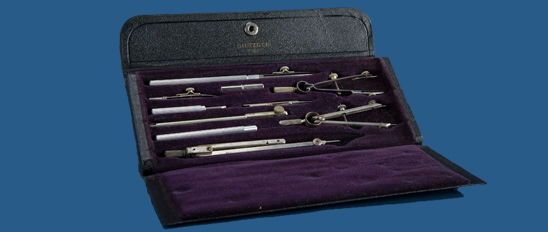This yellow metal case is covered with black imitation leather, lined with black foam, and fastened with a brass snap on a leather tab. The case is marked: VEMCO. A brochure for VEMCO's three types of drafting machines and drafting machine accessories is inside the case.
- Description
-
This yellow metal case is covered with black imitation leather, lined with black foam, and fastened with a brass snap on a leather tab. The case is marked: VEMCO. A brochure for VEMCO's three types of drafting machines and drafting machine accessories is inside the case. The set includes:
-
1) 6-1/2" stainless steel fixed-leg needle-point dividers marked on both sides: VEMCO USA. Blue dots are near the tips of the dividers.
-
2) 6-3/4" stainless steel bow pencil with blue dots near the points. The central nut is marked: VEMCO (/) MOD. L560 (/) U.S.A. PAT.
-
3) 4-3/4" stainless steel bow pencil with blue dots near the points. The central nut is marked: VEMCO (/) MOD. S570 (/) U.S.A. PAT.
-
4) 1-1/2" clear plastic cylindrical case with two leads and three needle points.
-
5) 2-1/8" stainless steel needle point in a small manila envelope marked: Contents (/) 61-9 Long Shoulder Needle (/) For Use With (/) VEMCO Pen Attachments.
-
6) 6" stainless steel extension bar marked: TOP.
-
7) 2-1/2" stainless steel extension needle point.
-
Francis E. Vaughan and Floyd Eubanks founded V & E Manufacturing, or Vemco Corporation, in Pasadena, Calif., in 1939 to make high-quality drafting instruments. Eubanks patented eight drafting machines and drawing instruments in the early 1940s. The marks on the bow pencils probably refer to his patents, "Compass" (U.S. Patent 2,297,999 issued October 6, 1942), and "Compass" (U.S. Patent 2,298,000 issued October 6, 1942), which dealt with the design of the instrument and the process by which the metal parts were punched out during manufacturing. According to the donor, this set was manufactured in 1987.
-
References: Vemco Drafting Products Corporation, http://www.vemcocorp.com/; accession file.
- Location
-
Currently not on view
- date made
-
1987
- maker
-
Vemco Corporation
- ID Number
-
1987.0589.03
- accession number
-
1987.0589
- catalog number
-
1987.0589.03
